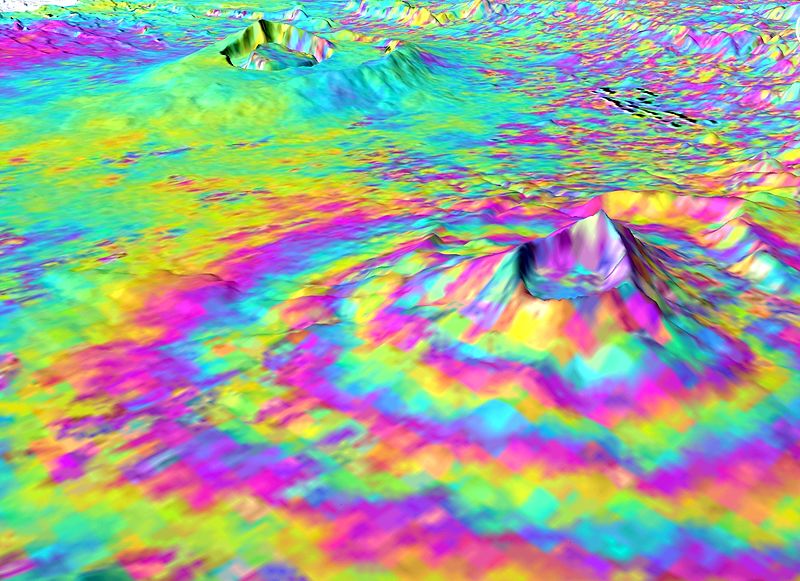Interferometric synthetic aperture radar InSAR

|
|
This Envisat Advanced interferometric synthetic aperture radar (InSAR) interferogram over the Kenyan section of the Great Rift Valley shows small surface displacements that are not visible to the naked eye of the Longonot volcano (front right). In the background is Suswa volcano, which was not deforming at this time. Using InSAR, a group of scientists discovered that from 1997 to 2000 the volcanoes at Suswa and Menengai (not visible) subsided 2cm to 5cm, and between 2004 and 2006 the Longonot volcano experienced uplift of around 9cm (pictured). Interferogram images appear as rainbow-coloured interference patterns. A complete set of coloured bands, called 'fringes', represents ground movement relative to the spacecraft of half a wavelength, which is 2.8cm in the case of Envisat's InSAR. |
Contents |
[edit] Introduction
Interferometric synthetic aperture radar (abbreviated as InSAR or IfSAR) is a technique that uses satellite or aircraft radar signals from multiple sources to capture complex and precise measurements.
[edit] Where it can be used
InSAR is a highly effective way to measure changes in land surface altitude. The technique uses two or more synthetic aperture radar (SAR) images and ‘interferes’ them to interpret differences and produce interferograms. This is an accurate way of detecting ground movements and can be scaled from single pixels (typically 3m x 3m or 4m x 14m) to entire countries.
Radar waves can be transmitted through most weather conditions and do not require daylight.
[edit] Geophysical disaster detection
The deployment of InSAR was first investigated in the 1980s, with additional exploration in the 1990s. One of the earliest practical applications of InSAR came in 1992, when it was used to measure the after effects of an earthquake in California.
Since those early applications, InSAR has been used to record data associated with landslides, volcanoes and other natural occurrences. In these instances, geotechnical engineers use InSAR as a safe, remote sensing technique for assessing and monitoring movement.
[edit] Subsidence
InSAR has proven effective at recording millimetre-scale shifts of land (such as subsidence). Subsidence can be tracked using historic satellite radar data covering previous decades and then monitored throughout the duration of a project and beyond.
InSAR has also been useful in recording the consequences of subsurface mining and natural resource extraction (both current and historic).
[edit] Structural instability
InSAR can also be used to record the stability of infrastructure (including highways, rail, dams and so on) and to monitor buildings. Movements can occur for a multitude of reasons - inadequate design or poor construction of foundations - but it can be difficult to capture the historic data.
NB Earth observation and aerial surveys, RICS professional standard, 6th edition, September 2021, published on 4 January 2022 by the Royal Institution of Chartered Surveyors (RICS), defines interferometric synthetic aperture radar (InSAR) as: ‘The measurement of the differences in the phases of the waves between two SAR images acquired over the same area at different times.’
[edit] Related articles on Designing Buildings
- Construction drones.
- Digital mapping and cartography.
- Earthquake Design Practice for Buildings.
- Engineers and hurricanes.
- Future proofing construction.
- Geophysical survey.
- Global positioning systems and global navigation satellite systems.
- LiDAR.
- Radar.
- Site surveys.
- Subsidence of buildings.
- Synthetic aperture radar.
- Using satellite imagery to monitor movements in megaprojects.
Featured articles and news
RTPI leader to become new CIOB Chief Executive Officer
Dr Victoria Hills MRTPI, FICE to take over after Caroline Gumble’s departure.
Social and affordable housing, a long term plan for delivery
The “Delivering a Decade of Renewal for Social and Affordable Housing” strategy sets out future path.
A change to adoptive architecture
Effects of global weather warming on architectural detailing, material choice and human interaction.
The proposed publicly owned and backed subsidiary of Homes England, to facilitate new homes.
How big is the problem and what can we do to mitigate the effects?
Overheating guidance and tools for building designers
A number of cool guides to help with the heat.
The UK's Modern Industrial Strategy: A 10 year plan
Previous consultation criticism, current key elements and general support with some persisting reservations.
Building Safety Regulator reforms
New roles, new staff and a new fast track service pave the way for a single construction regulator.
Architectural Technologist CPDs and Communications
CIAT CPD… and how you can do it!
Cooling centres and cool spaces
Managing extreme heat in cities by directing the public to places for heat stress relief and water sources.
Winter gardens: A brief history and warm variations
Extending the season with glass in different forms and terms.
Restoring Great Yarmouth's Winter Gardens
Transforming one of the least sustainable constructions imaginable.
Construction Skills Mission Board launch sector drive
Newly formed government and industry collaboration set strategy for recruiting an additional 100,000 construction workers a year.
New Architects Code comes into effect in September 2025
ARB Architects Code of Conduct and Practice available with ongoing consultation regarding guidance.
Welsh Skills Body (Medr) launches ambitious plan
The new skills body brings together funding and regulation of tertiary education and research for the devolved nation.
Paul Gandy FCIOB announced as next CIOB President
Former Tilbury Douglas CEO takes helm.
UK Infrastructure: A 10 Year Strategy. In brief with reactions
With the National Infrastructure and Service Transformation Authority (NISTA).






















